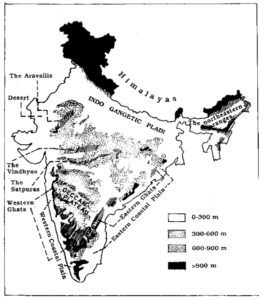India is a vast country with diverse topography and landforms. The Physiographic Regions of India can be divided into various parts.

Table of Contents
The Himalayan Region
The Himalayan Region is located in the northern part of India and is characterized by a complex network of mountain ranges and valleys. The region is home to some of the highest peaks in the world, including Mount Everest and Kanchenjunga. The Himalayan Region is also the source of several major rivers in India, including the Ganges, Brahmaputra, and Indus.
The Northern Mountains primarily consist of the Himalayas, which stretch from Jammu & Kashmir in the west to Arunachal Pradesh in the east. These young fold mountains were formed by the collision of the Indian and Eurasian tectonic plates.
-
Key Features:
-
Home to some of the world’s highest peaks, including Mount Everest (in Nepal) and Kanchenjunga.
-
Divided into three parallel ranges: Greater Himalayas (Himadri), Lesser Himalayas (Himachal), and Shiwaliks.
-
Important for climate regulation, water sources (glaciers), and biodiversity.
-
The Indo-Gangetic Plain
The Indo-Gangetic Plain is located in northern and eastern India and is one of the most fertile regions in the world. The region is characterized by a flat landscape and is fed by several major rivers, including the Ganges, Yamuna, and Brahmaputra.
Lying south of the Himalayas, the Northern Plains are formed by the alluvial deposits of the Indus, Ganga, and Brahmaputra rivers and their tributaries.
-
Key Features:
-
Extremely fertile and flat, making it India’s agricultural heartland.
-
Densely populated due to fertile soil and availability of water.
-
Subdivided into:
-
Punjab Plains
-
Ganga Plains
-
Brahmaputra Valley
-
-
The Peninsular Plateau
The Peninsular Plateau is located in central and southern India and is characterized by a complex network of plateaus, hills, and valleys. The region is rich in mineral resources and is home to several important rivers, including the Godavari, Krishna, and Cauvery.
This is the oldest and most stable landmass of India, composed mainly of igneous and metamorphic rocks. It is bordered by the Western and Eastern Ghats.
-
Key Features:
-
Divided into the Central Highlands and the Deccan Plateau.
-
Rich in mineral resources.
-
Drained by rivers like Godavari, Krishna, and Mahanadi.
-

The Western Ghats
The Western Ghats are a mountain range located along the western coast of India. The region is characterized by dense forests, waterfalls, and several important rivers, like Narmada, Godawari, Cauvery, etc.
The Eastern Ghats
The Eastern Ghats are a mountain range located along the eastern coast of India. The region is characterized by a series of low hills and plateaus and is home to several important rivers, including the Godavari, Mahanadi, and Krishna.
The Thar Desert
The Thar Desert is located in western India and is characterized by a dry and arid landscape. The region is home to several important cities, including Jaipur and Jodhpur.
Located in Rajasthan, this is a vast arid region characterized by sand dunes, high temperatures, and low rainfall.
Key Features:
-
-
Sparse vegetation and population.
-
Important for camel-based economy, solar energy, and cultural heritage.
-
River Luni is the only major seasonal river.
-
The Coastal Plains
India is surrounded by several coastal plains, including the Konkan Coast, Malabar Coast, Coromandel Coast, and the Andhra Coast. These regions are characterized by a flat and fertile landscape and are home to several important ports and cities.
In conclusion, India’s physiographic regions are a testament to the country’s rich geological and ecological diversity. By understanding these regions, we can gain a greater appreciation for the natural beauty and ecological significance of this vast and complex country.